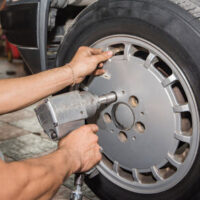How Performing Regular Tire Maintenance Can Help Keep You Safe

According to the National Highway Traffic Safety Administration (NHTSA), approximately nine percent of all car accidents are related in some way to a problem with a vehicle’s tires. In some cases, these car crashes could not have been predicted because the tires themselves were defective in some way. However, many could have been prevented if the driver had performed regular tire maintenance.
Tire-Related Problems
A failure to keep up on tire maintenance can cause a variety of problems. However, the most common include:
- Bald tires;
- Blowouts;
- Tread separation; and
- Under inflation.
Any of these issues, if left unaddressed, could have serious consequences. For instance, under-inflated tires make it harder to steer, put increased stress on other tire components, and make it more difficult to brake quickly.
Performing Your Own Tire Maintenance
Many drivers believe that to perform proper tire maintenance, they must hire a professional. However, tire maintenance can be relatively inexpensive if conducted regularly and in many cases, can be performed by the driver him or herself. For instance, car owners can take the following steps on their own:
- Check tire pressure at least once a month;
- Inspect tires for uneven wear patterns on the tread;
- Check for cracks;
- Remove bits of glass or other objects that have become wedged in the tread;
- Ensure that all tire valves have valve caps; and
- Avoid potholes and other road hazards when driving.
Drivers should also be familiar with the details of their specific tires. Generally, this information can be found on the placards and vehicle certification labels located on the car itself and will include:
- Recommended tire size;
- Recommended tire inflation pressure;
- Vehicle capacity weight; and
- The front and rear gross axle weight ratings.
This information is contained on labels that are attached either to the vehicle door edge, the door post, the glove box door, or the inside of the trunk lid. It can also be found in the owner’s manual.
Rotation and Replacement
Getting your tires rotated is a good way to reduce irregular wear, which means that your tires will also last longer. How often a car’s tires should be rotated will depend largely on the type of car. For example, some owner’s manuals direct drivers to rotate their tires every 5,000 miles and to do so according to a set pattern.
However, tires do eventually need to be replaced. Unfortunately, it can be difficult to determine whether a tire has aged to such a degree that replacement is necessary. One cheap and easy way is to examine a tire’s tread depth, by using the penny test, which only requires a driver to place a penny upside down into one of the tire’s groove. If the top of Lincoln’s head is visible, the tires should be replaced immediately. However, even when there is no evidence of tire aging, manufacturers recommend changing your tires every six to ten years.
Contact an Experienced Car Accident Attorney Today
If you were involved in a car accident caused by someone else’s negligence, please contact Boone & Davis in Fort Lauderdale to speak with an experienced car accident attorney who can explain your legal options.
Resource:
crashstats.nhtsa.dot.gov/Api/Public/ViewPublication/811617
